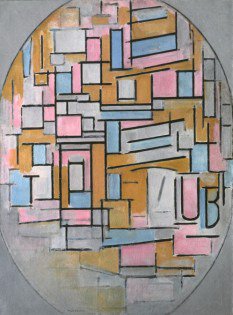Piet Mondrian
dal 3/9/2015 al 5/12/2015
Segnalato da
3/9/2015
Piet Mondrian
Martin Gropius Bau, Berlin
The Line. With about 50 paintings and drawings, the exhibition provides visitors with an insight into Mondrian's quest for his own artistic path.

Curated by: Hans Janssen
With his characteristic compositions of rectangles and black lines, Piet Mondrian (1872–1944) is regarded as one of the founders of abstract painting. He is considered to be a master of the composition of coloured areas. Through his method of strict reduction to the basic elements of painting, Mondrian created icons of classic modernism. A lesser-known fact, however, is that Mondrian started out by creating paintings in the impressionist style of the Hague School and explored different styles of art before lines and the organisation of image areas dominated his artistic creations. A new exhibition developed by the Gemeentemuseum Den Haag in cooperation with the Martin-Gropius-Bau now endeavours to illustrate this development in Mondrian’s works.
With about 50 paintings and drawings, the exhibition provides visitors with an insight into Mondrian’s quest for his own artistic path. The exhibition is the first major exhibition in Berlin to be dedicated to Mondrian since the opening exhibition of the Neue Nationalgalerie in 1968.
The exhibition shows a wide range of works of the Gemeentemuseum Den Haag which owns the world´s largest Mondrian collection. Benno Tempel, the Director of the Gemeentemuseum Den Haag, facilitated this project. The exhibition was curated by Mondrian expert Hans Janssen, a curator at the Gemeentemuseum.
“The first element of my painting to change was colour”, noted Mondrian in 1941. When making this statement, he omitted the fact that he had already made significant reductions to his drawings by gradually emphasising the relationships and rhythmic structures between vertical and horizontal lines. This influenced his work with colour and he developed from a traditionalist into a protagonist of modern art.
Piet Mondrian was born to a primary school teacher in the city of Amersfoort in the province of Utrecht in Holland on 7th March 1872. His family followed a strict principle of Calvinism. Mondrian studied at the Rijksakademie van beeldende Kunsten in Amsterdam and was interested in the painters of the Hague School and their painting technique.
His central themes were most notably fields, farms, windmills and recurrently trees and riversides. Mondrian began experimenting in around 1905. He sought out changing styles of painting and painting techniques on his motifs according to their light modulation, choosing an impressionist style of painting for a landscape bathed in sunlight and a fauvist-expressionist style for a landscape in evening light. Critics started to pay attention to him and in 1910, the group “Moderne Kunst Kring” (Circle of Modern Art) was formed with artists Jan Toorop, Jan Sluyters and Piet Mondrian. In 1911, they exhibited their works in the “Moderne Kunst Kring” exhibition at the Stedelijk Museum in Amsterdam together with French avant-garde artists including Cézanne, Braque and Picasso.
In the same year, one of Mondrian’s works was also featured in the “Salon des Indépendants“ in Paris. He moved to Paris in 1912. At this time, his work was influenced by Cubism, but his artistic interest tended to focus on the structure and organisation of image areas. Mondrian formulated his pursuit of “harmony through the equality of lines, colours and areas“. He schematised landscapes and transformed natural motifs into abstract compositions while increasingly using lines as vertical and horizontal elements. In 1913, his works were featured in Herwarth Walden’s major exhibition “Erster Deutscher Herbstsalon“ in Berlin. In 1914, Mondrian visited his ailing father and didn’t return to Paris until after the First World War. He then continued to dismantle figurative elements. He referred to his works as “compositions“, explored theosophy and went on to label his style as “neoplasticism“.
In the 1920s and 1930s, Mondrian exhibited his works in many locations such as The Hague, Amsterdam, Rotterdam, Stockholm, Paris, New York, Dresden, Berlin, Potsdam and Vienna. His financial success, however, was a long time coming. In order to survive, he still painted watercolours of flowers and accepts contract works.
As an art theorist and co-founder of the “De Stijl“ group of artists founded by Dutch painters, architects, designers, graphic artists and poets in 1917, Mondrian wrote pieces such as Le Néo-Plasticisme, the German translation of which was published as the Bauhaus Book no. 5 under the title “Neue Gestaltung. Neo-Plastizismus, Nieuwe Beelding.“ (New Design. Neo-Plasticisim, Nieuwe Beelding) in 1925.
Mondrian continued to work on his ‘compositions’ by simplifying his use of lines down to their extremes or giving them rhythm by forming a complex lattice structure and adding a few coloured areas. His paintings are defamed in Germany after 1933 as degenerate, some of his works were exhibited at the exhibition “Degenerate Art” in Munich in 1937. The Nazi regime and the impending World War Two led him to move to London in 1938 before relocating to New York in 1940.
In the USA and in New York in particular, his work was met with a great deal of interest. Many artists who had fled from Europe lived in New York in the 1940s. During this time, Mondrian brightened up his new works by using primary colours in a mosaic style and in doing so, transcended his earlier strict compositions in favour of a new rhythmic approach to the motif that could almost be described as musical. Mondrian died from the effects of pneumonia in New York on 1st February 1944.
The laconic structure of his later works was and continues to be reflected in architecture, fashion, advertising and popular culture right up to the present day.
Image: Piet Mondrian (1872 - 1944): Composition in oval with color planes 2, 1914. 113 x 84,5 cm, Oil on canvas © Gemeentemuseum Den Haag, The Netherlands
Press Contact:
Christiane Zippel, presse@gropiusbau.de
Opening: 4 September 2015
Martin-Gropius-Bau
Niederkirchnerstraße 7, Berlin
Wed - Mon 10am to 7pm



